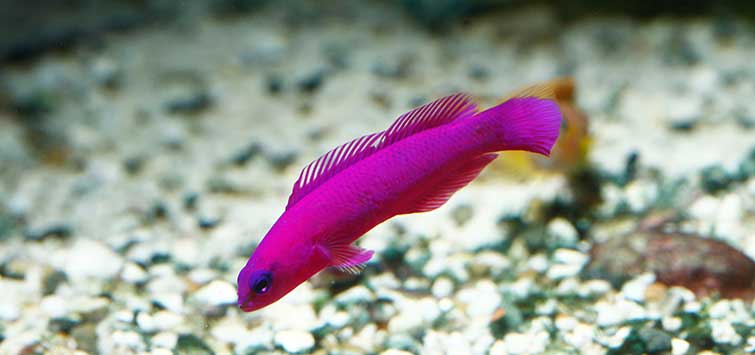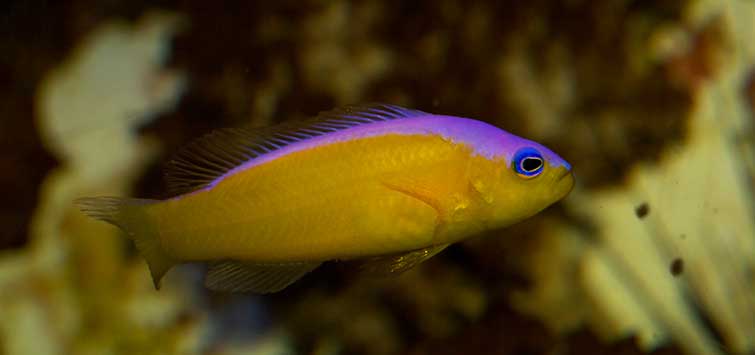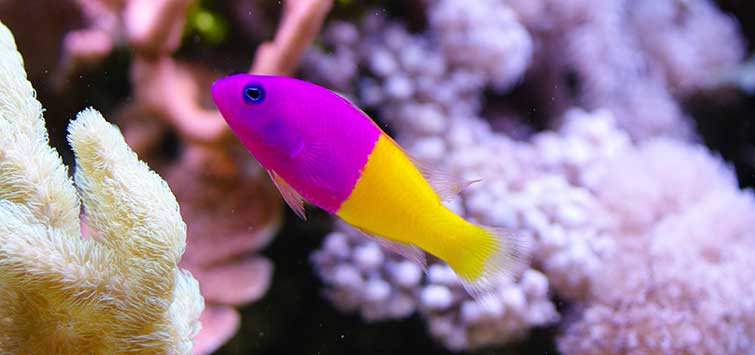Pseudochromis fridmani
Common Names: Orchid dottyback
Type Locality: Eilat, Israel, Gulf of Aqaba
Range: Red Sea only
Taxonomic Troubles: None. This is the original name.
Size: 6.3 cm (2.5 inches)
Preferred Water Chemistry: Tropcial marine. Temperature 24 to 26 degrees Celsius (75 to 79 degrees Fahrenheit)
Difficulty: A very hardy marine, available as captive-bred specimens.
Tank Setup: Their natural habitat is vertical reef structures or overhangs with many tiny crevices and holes--so plenty of live rock is perfect. Tankmates must be chosen with great care due to the potentially aggressive nature of these little fish.
Feeding: A robust feeder on most aquarium fare; captive-bred animals eat anything. Although they leave sessile stinging invertebrates alone, they will hunt down small motile invertebrates, including young bristleworms.
Breeding: This species is bred commercially, and hobbyists often have spawnings in their tanks.
Fish Description
Slender and extremely elongate. Overall hot pink, with blue-violet overtones, especially on the fin edges and on the face. Eyes are blue, with a dark band running obliquely from the snout through the eye.
Notes
This fish makes an ideal aquarium inhabitant, constantly darting in and out of its favorite nooks and crannies, ever on the lookout for a morsel of food or an interloping tankmate. The wild-caught specimens were tough enough, but currently available tank-bred fish are tough as nails, ready to feed heartily on any meaty foods you offer.
Personality
A person first observing an orchid dottyback typically remarks on its incredibly brilliant coloration--and then on its feisty, non-stop personality. Its feistiness is about its only drawback. Like many small, brightly colored basslets, fridmani are intolerant of conspecifics, or of any other fish that are of similar size, shape, or color. Fortunately, this dottyback is only moderately aggressive for the group. While it is best to have only one specimen to a tank and to select larger, very dissimilar fish as tankmates (letting them get established before adding the dottyback), many aquarists maintain more than one in a large tank with plenty of rockwork. The successful cases inevitably feature either a pair or harem of one male and several females. To maximize the chance of obtaining such a grouping, you should select the largest individual and one or more of the smallest ones, then add them all at once to the tank.
Spawning
You may very well observe spawning. The male will court a female, enticing her to his lair with an energetic dance. Spawning takes place in the cavern nest, and the egg mass is tended by the male until the fry hatch, at which time the larvae join the plankton raft. The literature contains many accounts of methods of rearing the fry.
Small, hardy, colorful, and generally reef safe, Pseudochromis fridmani is an ideal choice for most community marine aquaria.

.png?h=595&iar=0&w=2781&hash=5FD5E69473BCC22199FBFA2FB71B6033)



